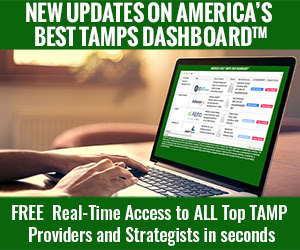
(Adhesion) In recent years, the demand for sustainable investing has increased dramatically. According to the Forum for Sustainable and Responsible Investment’s 2020 trends report and CNBC, of the $51.4 trillion in total US assets under professional management, $17.1 trillion, or roughly 33%, were U.S.-domiciled sustainably invested assets. In other words, about one-third of US assets under professional management fell into the sustainable investing category. This figure represents roughly a 42% increase between 2018 and 2020.

As this patterned growth continues, RIAs need to find an easy and convenient way to offer an option to their clients that includes environmental, social, and governance (ESG) criteria. One of the ways in which you, as the advisor, can offer this service is through the usage of direct indexes. In this blog, we will cover what direct indexes are, how they relate to ESG factors, and how RIAs use these types of solutions to incorporate their clients’ ESG preferences to differentiate and grow their firm.
Introduction to Direct Indexes
A Direct iIdex is a portfolio of stocks whose purpose is to track the movement and overall characteristics of an index. The individual investor directly owns the shares and therefore controls the ability to tailor the specific investments. In its simplest form, a Direct Index is an exact replica of the holdings and their respective weights inside of an index. For an advisor who wishes to have their client invest in the Russell 1000, the account would need to hold all 1000 securities. The challenge, therefore, has historically been finding an account with sufficient size to hold all 1000 securities, thus explaining the popularity of the index fund or ETF as a convenient vehicle to invest into an index.
However, the challenges with mutual funds and ETFs are well known – they are expensive, tax inefficient, and as a pooled vehicle, they are incapable of being personalized.
The Evolution of Direct Indexes
Two important technological advances emerged over the last decade to help leapfrog Direct Indexes into an important position of prominence. Mean-variance optimization tools – which attempt to identify common factors in securities that show a high degree of correlation to one another - allowed professional investors to shrink the full constituency of an index down to a more manageable basket of stocks without losing the integrity of the index it was attempting to follow. This means that the Russell 1000, as an example, can be distilled down to 1000 holdings, making the index accessible to a far broader advisory community and their clients than the first generation of Direct Indexes.
Some of the potential benefits of direct indexing include increased individual holding transparency, reduced cost, tax efficiency, and the ability to customize based on your clients’ needs. This final benefit around customization plays a pivotal role in the relationship between Direct Indexes and ESG, which we will discuss momentarily.
Now, with the advantages the Direct Index has over the mutual fund or ETF, advisors were soon faced with another challenge - finding a way to automate the management and oversight of the Direct Index. This led to the second technological advancement - the Unified Managed Account (UMA) - and the function of the Overlay Manager who operates as a quarterback over the Direct Index and assumes the role of portfolio administrator.
The UMA is one of the most important technical advances in managed investing over the past decade.It allows the advisor to place a Direct Index into a single account, then surround it with other managers. Many advisors use the UMA structure to build core/satellite portfolios where the Direct Index is at the core, then various satellite managers are used to round out the allocation. This permits the Overlay Manager to generate losses via tax harvesting from the larger Direct Index core to offset gains generated by the alpha-seeking satellite managers – in an attempt to keep the portfolio tax neutral. And since the Direct Index has a large allocation in the portfolio and has a lower price, the total blended fee is much more affordable than a traditional actively-managed allocation. It also means that the portfolio can be used to reflect a client’s unique environmental, social or governance preferences by absorbing these factors into the optimization process.
These types of low cost and highly personalized investment solutions create a level of stickiness between the advisor and client that can be difficult to replicate elsewhere. And since it’s outsourced to an Overlay Manager, the advisor is not inundated with technology and support costs, making it an infinitely scalable – and highly differentiated – solution.
Direct Indexes and ESG
With direct indexing, then, you are able to offer your clients a variety of investment options that align with their personal beliefs and goals. According to a 2019 report from Morgan Stanley, 85% of individual investors surveyed were interested in sustainable investing. This number jumps up to 95% when looking at millennial investors. The survey further indicates that 84% of individual investors desire portfolios constructed with their ESG preferences in mind. And 86% of those polled would prioritize financial gains below the value of advancing the causes that are most important to them. Direct indexing allows you to do just that - yet without potentially compromising performance.
For example, say you have a client who believes in supporting companies with a strong track record in promoting corporate governance, and wish to invest in those companies with strong governance policies. They also believe in sustainable investing, and therefore prefer to invest in companies that pursue positive social and/or environmental impact as their mission. Finding a mutual fund or ETF with this very specific mandate will be tricky and understanding how to allocate the managers inside of a risk-based allocation is nearly impossible. Instead, you can use direct indexing and apply the appropriate ESG Modules to an S&P 500 Direct Index in order to align with the performance of the index whilst adhering to your clients’ values.
Using Direct Indexes to Differentiate & Grow
Most advisors do not have access to this set of capabilities and therefore try to recreate this solution using mutual funds and ETFs. And that’s where you can win – by offering a lower cost, more highly personalized, and tax efficient index-based solution that takes your clients' sustainable preferences into account and is unlikely to be matched by your competitors. This can translate to a stronger relationship with your clients.
Additionally, as commission-free trading becomes more widespread due to the rise of Robinhood, Fidelity, E-Trade, and other such platforms, the need for differentiation is at an all-time high for RIAs. There has been a democratization of personal investment in recent years that has led to an increase in self-directed investing. RIAs can leverage Direct Indexes to reduce their own fees and costs in order to become more competitive with the fee-free trading platforms while providing their clients access to the expertise of an advisor.



